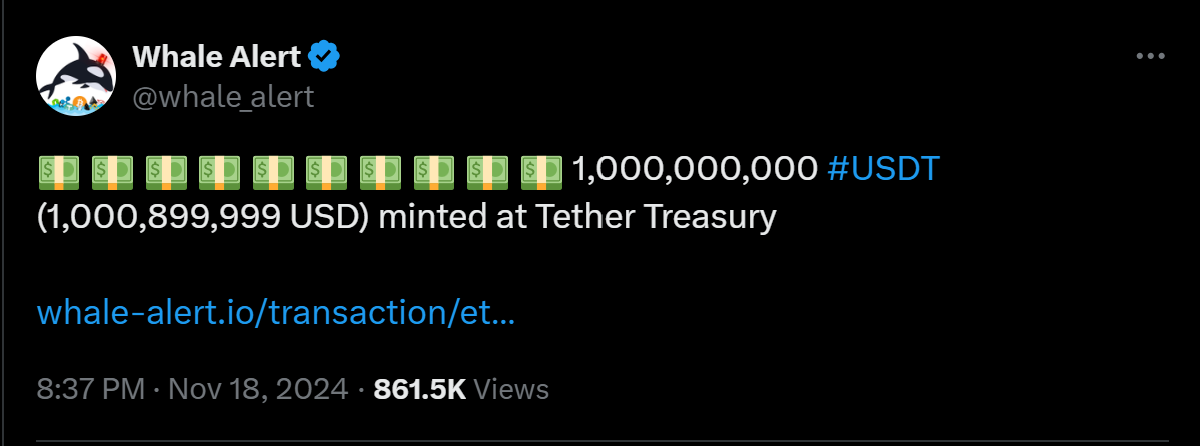In a latest move, Tether Treasury has created an additional $1 billion USDT on the Ethereum blockchain based on the information retrieved from Etherscan.
This transaction was noted on November 18 and is accompanied by a previous $1 billion USDT transfer to Tether’s treasury on the Tron network done just several days before.
These transactions are a part of a series of actions that Tether is taking to provide enough reserves for future market needs
Significantly, these newly minted stablecoins remain authorised but not yet in circulation, according to Tether’s CTO, Paolo Ardoino.

In addition, Ethereum remains the most popular network for Tether’s regulated USDT issuance with over $62.9 billion in the market. In contrast, the Tron network has $62.7 billion in authorized USDT.
This rivalry between the two networks underscores the need for stablecoin liquidity within various blockchain networks.
The stablecoins in reserve will be used to meet the expected demand in the decentralized and centralized markets.
Tether’s Investment in Quantoz for MiCAR-Compliant Stablecoins
Besides its minting updates, Tether has revealed a partnership with Quantoz Payments to support the creation of EURQ and USDQ stablecoins.
These tokens, which are anchored to the euro and the US dollar, respectively, are MiCAR-compliant, indicating the EU’s focus on harmonization with other markets.
Furthermore, this is a significant move towards enhancing the Tether presence in the regulated digital financial products market.
The EURQ and USDQ stablecoins shall revolutionise the European financial systems and provide more efficient and less expensive means of payments than the conventional systems.
They will improve the efficiency of cross border transactions particularly for the retail and institutional markets.
Through offering the blockchain-solutions, Tether and Quantoz aim at solving the existing problems of the conventional finance system.
Hadron by Tether Powers Comprehensive Tokenization
Supporting this initiative is Hadron by Tether, a sophisticated platform designed to govern the entire lifecycle of tokenized assets.
In particular, Hadron provides services for token creation, distribution, and governance, along with solutions for Know-Your-Customer (KYC) and Know-Your-Transaction (KYT) requirements.
Furthermore, the platform features risk management and wallet integration which enable the connection of the blockchain networks with the centralised digital asset exchanges..
By introducing Hadron, Tether wants to build the foundation for tokenization that is applicable to other fields aside from stablecoins.
This technology allows institutions to tokensise various digital assets such as stocks, bonds, real estate, and even loyalty points.
Thus, the platform contributes to the development of Tether’s ecosystem and opens up the way for tokenized assets in traditional markets.
Enhancing Financial Inclusion and Economic Accessibility
Expanding on these achievements, Tether’s investment in Quantoz is in line with a wider aim of enhancing financial accessibility and inclusivity.
Thus, Tether strives to create a set of new financial instruments that would help to establish a clear connection between block chain and other well-established financial systems.
In addition, Quantoz as the first institution that adopted Hadron by Tether is providing the example for other institutions and companies to consider asset tokenization.
This has already garnered interest from companies around the world who wish to adopt Hadron for several purposes.
Tether is revolutionizing the digital economy through provision of asset tokenization and smooth cross-border transactions.
With these releases, Tether remains a leader in the stablecoin market and a driving force for innovation in the ecosystem.
Since the creation of the first stablecoin USDT, Tether continues to lead the way in the market which has now grown to nearly $200 billion in capitalization.
This approach enhances its market reach and secures the growth and development of blockchain based financial services globally.
 thecoinrepublic.com
thecoinrepublic.com